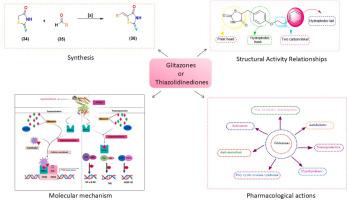几十年前的格列酮作为PPAR-γ激动剂仍然在药物发现中找到利基:药物化学观点,构效关系和治疗意义
IF 3
3区 医学
Q2 BIOCHEMISTRY & MOLECULAR BIOLOGY
引用次数: 0
摘要
糖尿病,特别是2型糖尿病(T2D),由于与胰岛素抵抗和高血糖相关的生理变化,仍然是一个严重的全球健康挑战。它引起发病率和死亡率,从而给卫生保健系统带来财政负担。噻唑烷二酮或格列酮是一种已有十年历史的成熟药效基团,作为过氧化物酶体增殖物激活受体γ (PPAR-γ)激动剂,继续在药物发现中发挥重要作用,在结构-活性关系和治疗应用方面为药物化学提供了有价值的见解。这篇综合综述探讨了格列酮的生物学及其与PPAR-γ受体的相互作用,特别强调了它们在T2D中调节葡萄糖代谢的作用。讨论了从第一代到第三代格列酮的进展,重点介绍了选择性PPAR-γ调节剂(SPPAR-γ ms)的进展,旨在提高疗效和安全性,同时最大限度地减少诸如液体潴留、体重增加和心血管风险等不良反应。本文主要从药物化学、SAR/QSAR、分子对接、药效团建模等方面综述了格列酮的合成策略。本文解释了传统方法和利用天然底物作为生物等容替代物来提高效力和安全性。除了抗糖尿病作用外,格列酮还具有抗癌、神经保护、抗炎和肝保护剂的多效作用。其治疗相关性扩展到非酒精性脂肪性肝病(NAFLD),非酒精性脂肪性肝炎(NASH)和多囊卵巢综合征(PCOS)最近的临床试验支持。本综述还讨论了局限性和毒性,包括需要更安全、更有效的PPAR调节剂。总之,这篇综述强调了格列酮在代谢性疾病中的重要性,强调了新的突破,并确定了令人兴奋的药物发现的新方向。本文章由计算机程序翻译,如有差异,请以英文原文为准。

Decades old glitazones still find niche in drug discoveries as PPAR-γ agonists: medicinal chemistry perspective, structure-activity relationships and therapeutic implications
Diabetes Mellitus, specifically type 2 diabetes mellitus (T2D), remains a serious global health challenge owing to the physiological changes linked with insulin resistance and hyperglycemia. It causes morbidity, mortality, and thereby financial burden on healthcare systems. Thiazolidinediones or glitazones, a decade-old, well-established pharmacophore, continue to play an important role in drug discovery as peroxisome proliferator-activated receptor gamma (PPAR-γ) agonists, offering valuable insights into medicinal chemistry in terms of structure-activity relationships and therapeutic applications. This comprehensive review explores the biology of glitazones and their interactions with the PPAR-γ receptor, with a particular emphasis on their role in modulating glucose metabolism in T2D. Discussed the progression of glitazones from first- to third-generation, highlighting advances in selective PPAR-γ modulators (SPPAR-γMs) aimed to enhance efficacy and safety while minimizing adverse effects like fluid retention, weight gain, and cardiovascular risks.
This review mainly focuses on medicinal chemistry, SAR/QSAR, molecular docking, and pharmacophore modelling and outlines the synthetic strategies for glitazones. Both conventional methods and the exploitation of natural substrates as bioisosteric replacements to enhance potency and safety profiles are explained. In addition to antidiabetic effects, glitazones are known to exhibit pleiotropic roles as anticancer, neuroprotective, anti-inflammatory, and hepatoprotective agents. Their therapeutic relevance extends to non-alcoholic fatty liver disease (NAFLD), non-alcoholic steatohepatitis (NASH), and polycystic ovary syndrome (PCOS) supported by recent clinical trials. This review also discusses limitations and toxicity, including the need for safer and more efficacious PPAR modulators. Overall, this review emphasizes the importance of glitazones in metabolic disease, highlights new breakthroughs, and identifies exciting new directions for drug discoveries.
求助全文
通过发布文献求助,成功后即可免费获取论文全文。
去求助
来源期刊

Bioorganic & Medicinal Chemistry
医学-生化与分子生物学
CiteScore
6.80
自引率
2.90%
发文量
413
审稿时长
17 days
期刊介绍:
Bioorganic & Medicinal Chemistry provides an international forum for the publication of full original research papers and critical reviews on molecular interactions in key biological targets such as receptors, channels, enzymes, nucleotides, lipids and saccharides.
The aim of the journal is to promote a better understanding at the molecular level of life processes, and living organisms, as well as the interaction of these with chemical agents. A special feature will be that colour illustrations will be reproduced at no charge to the author, provided that the Editor agrees that colour is essential to the information content of the illustration in question.
 求助内容:
求助内容: 应助结果提醒方式:
应助结果提醒方式:


